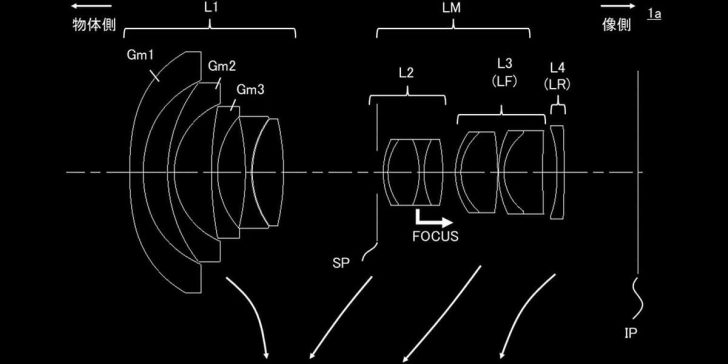Correction: These optical formulas are for full-frame sensors.
We know that an RF-S wide angle zoom lens is coming later in 2023 to take the place of the EF-M 11-22mm f/4-5.6 IS STM and EF-S 10-18mm f/4.5-5.6 IS STM. A much needed type of lens for any crop sensor camera.
There are two optical formulas covered in this patent, and it's nice to see both have a constant aperture.
There was also a previous patent for an RF 11-24mm f/4 that you can see here.
Canon RF-S 9-18mm f/4
- Zoom ratio 1.88
- Focal length 9.27mm 13.03mm 17.46 mm
- F value 4.12 4.12 4.12
- Half angle of view 63.98 56.92 51.10
- Image height 19.00mm 20.00mm 21.64mm
- Total length 108.47mm 102.77mm 100.80mm
- Back focus 15.71mm 19.67mm 23.00mm
Canon 10-18mm f/4
- Zoom ratio 1.74
- Focal length 10.01mm 13.27mm 17.46mm
- F number 4.12 4.12 4.12
- Half angle of view (°) 62.23 56.44 51.10
- Image height 19.00mm 20.00mm 21.64mm
- Lens length 110.09mm 104.20mm 100.83mm
- BF 15.91mm 15.91mm 15.91mm
This patent was uncovered by The Camera Insider (but misinterpreted) via the JPO, you can view the patent here.
Some of our articles may include affiliate links. If you purchase through these links, we may earn an affiliate commission at no extra cost to you.


I would love too see an 9-18mm lens for APS-C, but the image height quoted on these patents, doesn't that points towards lenses for fullframe format?
Lenses always cover a greater area than ultimately needed for the respective format, so this looks in line with apsc
Wide-angle lenses are sometimes a little less and use image stretching.
But still much more than the about 13.4 mm a Canon APS-C sensor would need.
Fixed aperture would normally point towards FF and L lens, wouldn't it?
Canon has had fixed aperture APS-C zooms before like the EF-s 17-50 f/2.8 IS and also the legendary super 35 CN-E 18-80mm T4.4 and CNE 70-200 T4.4 hybrid cine lenses with AF and IS.
The lens formulas in the patents are quite clearly full-frame though
The Image height is the radius and therefore half the diameter.
For FF, the sensor dimensions are 26x24 mm. The diagonal is 43.27 mm. the Radius 21.633 mm, so better take 21.64 mm ;)
Maybe this quick drawing can help.
It only comes at the expense of a more favorable f-number at the wide end!
So i.e. a 9-18 mm f/4.0 constant aperture might as well have been 9-18 mm f/2.8-4.0.
Personally, I don't blame you or CR or third party for misinterpreting the patent, but having fun in discussing the technical details :)
Sorry!
For example, I really do look forward to the Tamron 35-150 f2-2.8 coming in RF mount as it would be the perfect do-it-all wedding lens instead of having two bodies with a 24-70 and a 70-200; but if that will come, I would directly use it as a f2.8 constant aperture, because I don't want to mess with changing exposure constantly.
I actually do have a variable aperture lens, the 28-105 f3.5-4-5 which is my emergency back up wedding lens if the 24-70 dies unsuspectedly, and my holiday/backpacking lens; when I use it, I directly set it at the minimum common brightest aperture (f4.5) because it's easier to work with. SO even if I can get f3.5 at the wide end and f4 around the 35mm/50mm mark, I never exploit it, for me it's just a f4.5 constant lens (which for only 50€ is btw just 1/3rd stop darker then the 24-105 L's, so perfectly able to do a wedding in emergency; and no, it doesn't suck, I have an incredibly blessed copy which is as sharp as the 24-70 L II /24-105 L II at comparable apertures, while it's much better then both Mk I versions).
I am pretty sure there are more people who would prefer the perfectly useful wider aperture at the wide end, than there are people wanting to pay extra to get rid of it.
The way I work (and I'm pretty sure it's the way most professionals work) is "a lens is as good as its darkest base aperture"; I would never buy a lens thinking "well, it's f4 on the long end but hey, I can get f2.8 at the wide end so it's somewhat an f2.8 lens in some way".
If I need an f2.8 aperture, I buy f2.8 lens, if I'm ok with f4 aperture, I buy f4 lens; THEN, if I need an f4 lens, and there's an f2.8-4 lens that is as good (or better) then the f4 and cost same (or less), THEN I'll buy it of course, and I'll know that there's an "emergency f2.8 setting at the wide end", but I would still consider it a constant f4 lens for the purposes of my work.
If I need to count on that f2.8 then the entire lens must be f2.8 all the way
In other words, I suspect people would be fine with an f/2.8-4 zoom, and would prefer that over a constant f/5.6 zoom. But neither of those are real options from Canon, where constant = fast and variable = slow…i.e., real options are f/2.8 or f/4 vs. e.g. f/4.5-7.1.
That behavior can be easily controlled with the custom function settings.
EDIT: found it for R6 on user manual. I don't think it's there for the RP, as the camera has come last week so I just configured, and don't remember that, but I'll also look there.